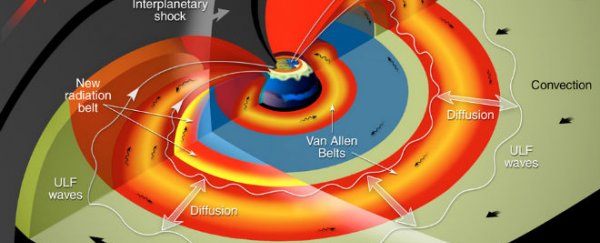For the first time, scientists have recorded the effects of a solar shockwave from beginning to end, as it tore past Mercury, Venus, and the Moon, and blasted the protective magnetic field that surrounds our planet.
The event was recorded by NASA's Van Allen Probes - twin spacecraft that have been send to orbit the radiation belts located deep inside Earth's magnetic field. Known as the Van Allen radiation belts, these two doughnut-shaped layers of charged particles extend from an altitude of around 1,000 to 60,000 kilometres above the surface of our planet, and prevent the fastest, most energetic electrons from reaching Earth.
While the event was recorded way back in 8 October 2013, it's taken scientists at MIT's Haystack Observatory and the University of Colorado, both in the US, over a year to retrieve the data and figure out what actually happened. They say that once the shockwave hit the Van Allen radiation belts, a huge 'magnetosonic pulse' - a high-energy, magnetised sound wave - reverberated through them for 60 seconds. This sound wave caused certain low-energy particles to be accelerated to dangerously high energy levels, which meant that suddenly, things were a whole lot less hospitable just outside Earth's atmosphere.
"These are very lightweight particles, but they are ultrarelativistic, killer electrons - electrons that can go right through a satellite," John Foster, associate director of MIT's Haystack Observatory, said in a press release. "These particles are accelerated, and their number goes up by a factor of 10, in just one minute."
Each ultrarelativistic, killer electron can contain close to 1,000 times more energy than you receive in a dental X-ray, says NASA, so you do not want one of these bombarding your satellite or spacecraft. They can easily penetrate the thick outer shielding of spacecraft, and can absolutely scramble any onboard electronics, which is a literal nightmare if you happen to be inside the spacecraft at the time.
That's why the twin NASA probes were sent up into the Van Allen radiation belts in 2012 - to help scientists figure out how and when killer electrons form, how they behave, and how long they last. And if they can't be avoided, scientists need to figure out how to build stronger and more durable spacecraft that can withstand the effects.
During the October 2013 event, the Van Allen probes were circling Earth with about an hour between them, so one was able to capture the events that preceded the shockwave blast, and the other captured those that followed it. The observations have been described in the Journal of Geophysical Research, and Foster breaks down the sequence of events at ScienceDaily:
- As the solar shockwave made impact, it struck "a sledgehammer blow" to the protective barrier of the Earth's magnetic field.
- Instead of breaking through this barrier, the shockwave 'bounced' away.
- This produced a magnetosonic pulse, which then travelled in the opposite direction.
Throughout its journey, the magnetosonic pulse gathered up lower-energy particles and accreted them to energies of 3 to 4 million electronvolts. This increased the number of ultrarelativistic, killer electrons in the Van Allen radiation belts to 10 times the amount that had existed before the solar shockwave event.
What's amazing is not only is this event common, it actually happens a couple of times a month, but the October 2013 event wasn't even a very big one. In fact, it was pretty tame, compared to some others the Earth's protective layers have experienced.
"This was a relatively small shock. We know they can be much, much bigger," Foster says. "Interactions between Solar activity and Earth's magnetosphere can create the radiation belt in a number of ways, some of which can take months, others days. The shock process takes seconds to minutes. This could be the tip of the iceberg in how we understand radiation-belt physics."
